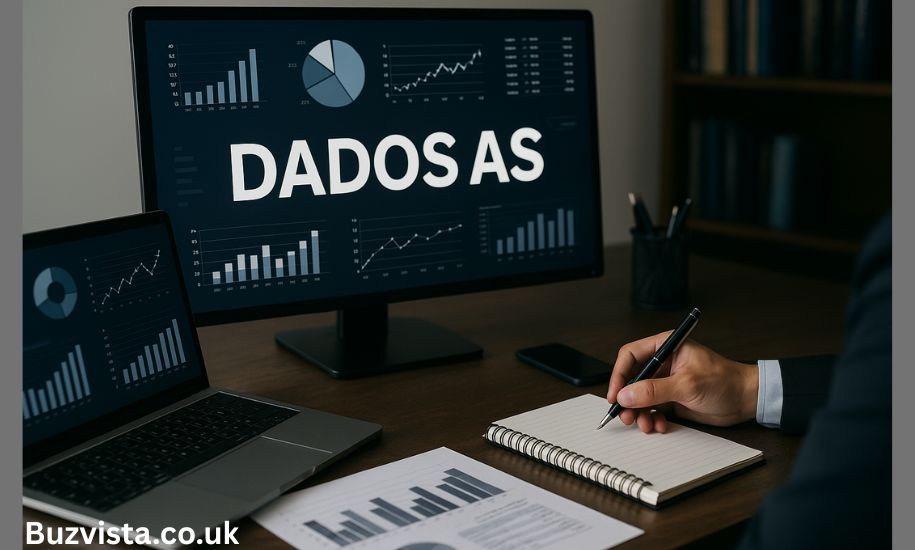In the rapidly evolving world of technology, new service models constantly reshape how businesses operate. We are already familiar with concepts like Software as a Service (SaaS), Infrastructure as a Service (IaaS), and Platform as a Service (PaaS). But another model is quietly gaining traction—“Dados As”, which translates from Portuguese as Data as a Service (DaaS).
In simple terms, “Dados As” represents the delivery of data as an on-demand service. Instead of companies having to build, manage, and secure their own data pipelines, they can access clean, reliable, and integrated data through APIs or managed platforms. It allows organizations to focus less on the plumbing of data management and more on turning that data into actionable insights.
This article explores the foundations of “Dados As,” how it works, its advantages and challenges, key use cases, and why it’s becoming essential for modern organizations striving to become data-driven.
The Origin and Context of “Dados As”
The “As a Service” Revolution
The term as a Service originated with the rise of cloud computing. It reflects a broader shift from ownership to access—organizations no longer need to purchase expensive infrastructure or software upfront; instead, they rent what they need, when they need it.
“Dados As” or Data as a Service extends this principle to the realm of data itself. Just as SaaS delivers applications via the internet, DaaS delivers data—collected, cleaned, processed, and ready for use—through the cloud. This approach dramatically simplifies how companies acquire and utilize data, removing the burden of maintaining complex backend systems.
Several forces have driven the growth of this model:
- Explosive growth in data generated from users, sensors, and digital systems.
- The increasing need for real-time insights and decision-making.
- Fragmented and siloed internal data systems.
- The high cost and complexity of building and maintaining data infrastructure.
As organizations become more reliant on analytics, AI, and automation, accessing reliable, ready-to-use data through the cloud is no longer a luxury—it’s a necessity.
How “Dados As” Works
At its core, a “Dados As” or DaaS platform follows a pipeline that manages the full lifecycle of data—from ingestion to delivery. Here’s how the process typically unfolds:
1. Data Sources
Data is gathered from various origins such as databases, APIs, IoT devices, sensors, and user activity logs.
2. Ingestion and Extraction
Pipelines extract and load data (via ETL or ELT processes) into centralized storage systems, either in real-time or batches.
3. Transformation and Cleaning
Data is standardized, deduplicated, validated, and enriched. This ensures that clients receive data in consistent, high-quality formats.
4. Storage and Indexing
The processed data is stored in cloud environments—data lakes, warehouses, or columnar databases—optimized for performance, accessibility, and compliance.
5. Service Layer / API Delivery
The clean data is exposed through APIs, dashboards, or direct connections to analytics tools. Clients can query or integrate it into their own applications.
6. Security, Governance, and Compliance
The service includes strict access control, encryption, anonymization, and compliance with data protection regulations such as GDPR and LGPD.
7. Monitoring and Scalability
Automated monitoring ensures uptime, performance, and elastic scalability as the client’s data needs grow.
8. Consumption by Clients
Finally, the client consumes the data through dashboards, machine learning models, reports, or third-party integrations.
This model transforms data from a static resource locked in silos into a dynamic service accessible anywhere, anytime.
Key Benefits of “Dados As”
Implementing a “Dados As” approach brings numerous advantages that extend beyond cost savings:
1. Speed and Agility
Data is ready for analysis within hours or days rather than months. Teams can experiment, iterate, and make data-driven decisions faster than ever.
2. Cost Efficiency
By outsourcing infrastructure and maintenance, companies reduce capital expenses and operational overhead. They only pay for what they consume.
3. Scalability
As data volumes grow, the DaaS model automatically scales up without the need for new servers or internal configurations.
4. Accessibility and Democratization
Employees across departments can access the same reliable datasets through APIs or dashboards, fostering a culture of data-driven collaboration.
5. Unified Data Sources
“Dados As” integrates multiple data sources—internal systems, third-party data, and real-time streams—into a single, unified format.
6. Enhanced Governance and Security
Centralized management ensures better oversight, compliance, and security than fragmented internal setups.
7. Enabler for AI and Advanced Analytics
Clean, well-structured data fuels machine learning, predictive analytics, and other AI applications, making “Dados As” a cornerstone for intelligent business solutions.
Real-World Applications and Use Cases
The versatility of the “Dados As” model means it can be applied across virtually every industry. Here are some illustrative examples:
E-Commerce and Retail
- Personalizing shopping experiences using behavioral data.
- Predicting product demand to optimize inventory.
- Analyzing cart abandonment and improving conversion rates.
Finance and Banking
- Real-time fraud detection and credit risk assessment.
- Integration of market and customer data for portfolio analysis.
- Enhancing regulatory compliance and reporting accuracy.
Healthcare and Life Sciences
- Aggregating clinical trial and genomic data for research.
- Enabling predictive diagnostics and personalized treatments.
- Powering telemedicine with real-time patient data.
Logistics and Supply Chain
- Tracking deliveries and optimizing transport routes.
- Forecasting supply and demand fluctuations.
- Integrating IoT and sensor data from vehicles and warehouses.
Marketing and Media
- Segmenting audiences using demographic and behavioral insights.
- Improving ad targeting and campaign effectiveness.
- Monitoring engagement, retention, and brand performance.
Government and Smart Cities
- Real-time urban data monitoring (traffic, energy, waste).
- Evidence-based policymaking using aggregated analytics.
- Promoting transparency with open data dashboards.
These examples highlight how “Dados As” serves as an accelerator of innovation across domains.
Comparing “Dados As” With Traditional Data Infrastructure
| Aspect | Traditional Infrastructure | “Dados As” / DaaS |
|---|---|---|
| Initial Investment | High (hardware, licenses, staff) | Low (subscription or pay-as-you-go) |
| Time to Deploy | Months or years | Days or weeks |
| Scalability | Manual and limited | Automatic and elastic |
| Maintenance | In-house responsibility | Handled by the provider |
| Integration | Often complex | Simplified via APIs |
| Governance | Managed internally | Shared with provider |
| Flexibility | Rigid and slow | Adaptive and fast |
Traditional systems give more control but demand more resources. “Dados As” trades a bit of control for immense agility and efficiency.
Challenges and Risks
Despite its many benefits, adopting a “Dados As” model comes with several considerations:
1. Data Quality
If the provider delivers incomplete or inaccurate data, your analytics will suffer. Continuous validation and strict SLAs are essential.
2. Integration With Legacy Systems
Older internal systems may not be compatible with modern APIs or formats, requiring migration work.
3. Vendor Lock-In
Dependence on one provider can create switching costs. Choose partners that offer data portability and clear exit strategies.
4. Security and Privacy
Sensitive data must be encrypted, anonymized, and handled according to privacy regulations. Weak security can lead to serious reputational and financial harm.
5. Performance and Latency
If applications rely on real-time responses, network latency can be a problem—especially when servers are located far from the client base.
6. Governance and Compliance
Shared responsibility between client and provider requires transparent rules and regular audits.
7. Cost Volatility
Pay-as-you-go pricing can spike unexpectedly if data usage suddenly increases. Monitoring and cost control are crucial.
To mitigate these risks, organizations should:
- Negotiate detailed SLAs and security terms.
- Establish internal data governance frameworks.
- Test the service with small-scale proofs of concept.
- Maintain backups or fallback strategies.
- Regularly monitor data quality and usage patterns.
Choosing or Building a “Dados As” Platform
Selecting a Provider
When evaluating a DaaS vendor, focus on the following criteria:
- Reputation and Trustworthiness – proven track record and client references.
- Performance and Scalability – ability to handle growing volumes without degradation.
- APIs and Integration – compatibility with your tools, workflows, and tech stack.
- Security and Compliance – encryption, certifications, and adherence to privacy laws.
- SLAs and Availability – guaranteed uptime, response times, and incident management.
- Pricing Model – transparent, predictable, and aligned to your usage patterns.
- Support and Documentation – responsive customer service and clear technical resources.
- Portability and Exit Options – easy export or migration if you change vendors.
Building Internally
Larger enterprises may prefer to build internal “Dados As” systems. To do so effectively:
- Start with a pilot project to test feasibility.
- Use modular architecture with microservices and APIs.
- Leverage cloud-managed infrastructure for scalability.
- Embed data governance from day one.
- Monitor costs and performance continuously.
- Provide training for engineers and analysts to consume data services efficiently.
A hybrid approach—some internal, some outsourced—is common and often the most practical.
Future Trends: The Next Evolution of “Dados As”
The future of “Dados As” looks bright, with rapid innovation ahead. Key trends include:
- AI-Ready Data Services: Providers will deliver curated datasets optimized for machine learning and predictive analytics.
- Real-Time Streaming: Continuous data flows will power instant decision-making.
- Composable Data Platforms: “Dados As” will become one module in a broader data ecosystem.
- Data Marketplaces: Businesses will buy and sell datasets securely as digital assets.
- Decentralized and Blockchain-Based Data: For greater transparency and traceability.
- Privacy-Enhancing Technologies: Differential privacy and homomorphic encryption to analyze data without exposing sensitive content.
- Automated Data Pipelines: AI-driven orchestration that reduces manual engineering work.
As data becomes the lifeblood of digital transformation, “Dados As” will stand at the center of the modern data economy.
Conclusion
The concept of “Dados As”—or Data as a Service—marks a fundamental evolution in how organizations handle information. Instead of treating data as a byproduct to be managed, it reframes data as a service to be consumed, optimized, and monetized.
By adopting “Dados As,” businesses gain agility, scalability, and cost efficiency while freeing teams to focus on innovation and strategic decisions rather than infrastructure maintenance.
Still, success requires careful planning: ensuring data quality, maintaining compliance, choosing the right provider, and avoiding vendor lock-in. With the right governance and strategy, “Dados As” becomes a catalyst for competitive advantage and digital growth.
To explore more insights, strategies, and future-focused discussions on technology, data, and business transformation—visit Buz Vista, your source for deep perspectives on innovation and digital progress.

